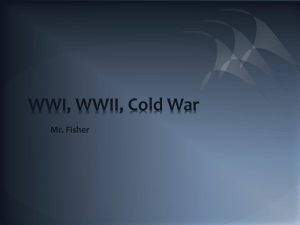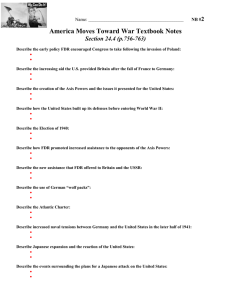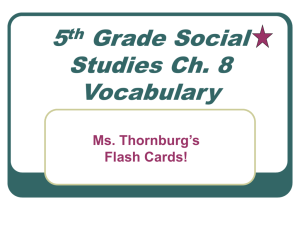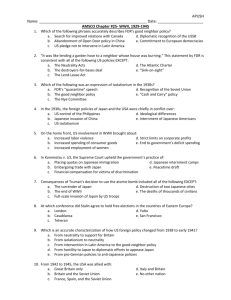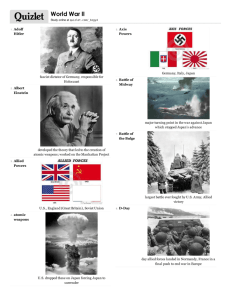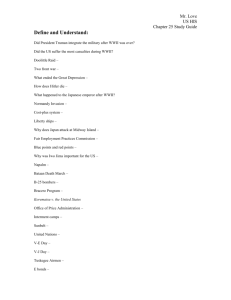America Moves Towards War
advertisement
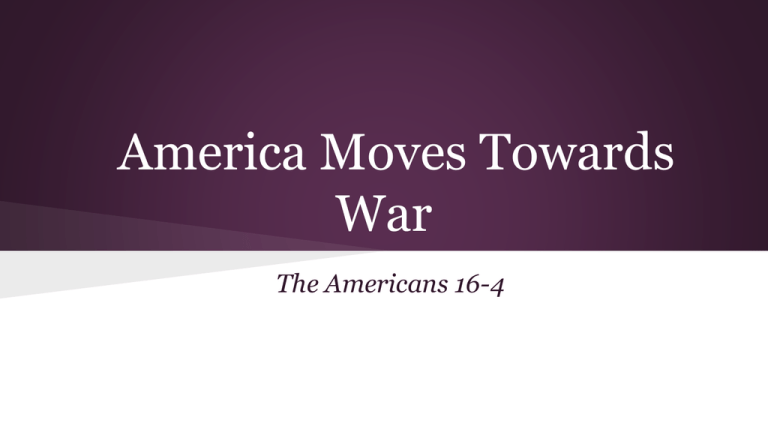
America Moves Towards War The Americans 16-4 Beginning of WWII • Treaty of Versailles was a major issue propelling the world towards WWI • War Guilt Clause - Germany should accept the blame for starting World War One • Reparations - Germany had to pay $10,303,854,000 for the damage caused by the war! • Disarmament - Germany was only allowed to have a small army and six naval ships. No tanks, no airforce and no submarines were allowed. The Rhineland area was to be de-militarized. • Territorial Clauses - Land was taken away from Germany and given to other countries. Anschluss (union with Austria) was forbidden. Beginning of WWII • Authoritarian leaders arose as people looked for new leaders to help them out of the world wide Great Depression. • • • • Joseph Stalin in Russia Adolf Hitler in Germany Benito Mussolini in Italy Hirohito/Tojo in Japan Leaders of WWII Beginning of WWII • Fascism, an ideology that stresses nationalism and placing the interests of the state above the individual, became popular in some countries (Italy, Germany). • Fascism promoted a single strong leader and a small group of devoted party members to lead the country. Beginning of WWII • The Nazis took over Germany in a coup in 1933. Hitler was their leader. • Officially they were: • • • • Anti-communist Anti-Jew (anti-Semitic) Promoted extreme nationalism with their pure “Aryan” race Wanted to create a “Third Reich” Beginning of WWII • Italy was also a fascist state supported by extreme nationalism. • Mussolini took over through fear tactics. • Supported militaristic expansion • Anti-communist • Believed in private property with strong government controls. Beginning of WWII • • • • The Soviet Union was NOT a fascist state, it was communist. Communists believe in a one party government and state ownership of property. Stalin took over the USSR in 1924. Made Russia into an industrial might. Had a totalitarian government which means Stalin tried to completely control his citizens. Individuals had no rights, and the government suppressed all opposition. Beginning of WWII Japan was also not a fascist country. Their prime minister, Tojo, led the country. • Japan was trying to create a Pan-Asian empire. Their motivations were the same as other imperial nations: • Military growth • Resources/markets • Believed in cultural superiority • Extreme nationalism • How the War Started: • The League of Nations did not take action against Germany or Italy when they began invading areas to create larger empires. This policy of allowing concessions in order to avoid war was called “appeasement”. This ultimately led to them continually working to take over or annex other places. • Germany invades Poland in 1939 and war is officially declared. How the War Started: • • • • • Italy and Germany had an alliance to support one another. The Soviet Union and Germany signed a “non-aggression pact” to not attack one another. Japan sides with these groups as well to promote their takeovers of land in the Pacific. Germany, Italy, and Japan are called the AXIS Powers during WWII. The Soviet Union takes over countries in the Baltic but is not a part of the AXIS Powers. How the War Started: • France is also invaded by Germany; Britain comes in to defend Poland and France leading to war. • France, Britain, (later the USA and Russia) and other countries are known as the Allied Powers. The US Musters Its Forces 1. Remember that the US was isolationist after WWI due to our disillusionment with the war and desire to stay out of Europe’s problems. 2. The US had followed a system of neutrality, supplying both sides with weapons and materials as long as they paid in “cash”. 3. We also began to boost defense spending and enacted the Selective Service Act despite the fact we weren’t at war. Great Arsenal of Democracy 1. We showed whose side we supported when we enacted a LendLease program to Britain, who had run out of money. We also did the same for the Soviets once they joined Britain. 2. In retaliation, German U-boat attacks on supply ships increased. FDR Plans for War 1. Britain and the US joined defenses under the Atlantic Charter, where we pledged to help one another. This showed whose side we were really supporting. 2. We also began shooting back at German Uboats since they were attacking our merchant ships. Japan Attacks the US 1. Japan had been on the move, taking over islands and countries across the Pacific region. 2. The US, in response to Japanese aggression, cut off their oil shipments, directly hurting Japanese military maneuvers. Pacific Theatre of War Japan Attacks the US 1. The Japanese warned that war would occur in retaliation for our actions. 2. Peace talks between the countries failed. 3. The Japanese attacked at Pearl Harbor on Dec. 7, 1941. http://www.youtube.com/watch?v=3e99lfmmDN0 Japanese attack at Pearl Harbor Japan Attacks the US 1. The attack on Pearl Harbor killed over 2400 Americans within 2 hours, making it the most devastating attack on the US until 9/11. 2. The US declared war on Japan the next day, and joined in the war fighting against Germany a few days later. War Powers • • • During war, presidential and government powers are often expanded. One example of this is the War Powers Act of 1941 and the War Powers Act of 1942. These acts were created to give the president emergency powers to create agencies or acts needed for the war effort. These acts sometimes step on the freedoms individuals are used to in peace times and sometimes conflict with our values of the rights to life, liberty, and property. Allied Powers 1. Britain 2. Soviet Union 3. France (occupied) 4. USA 5. Many other powers Axis Powers 1. Germany 2. Italy 3. Japan

